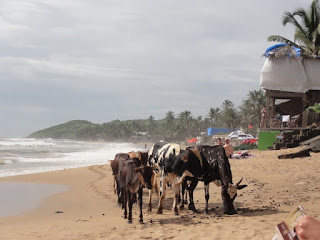We moved from the incessant honking of the crowded smoggy streets to the absolute calm and quiet (almost too much so) of Goa. The tiny beach paradise state located a few hundred miles south of Mumbai, but might as well be on another continent. Palm trees and beach shacks replaced the dump trucks and rush hours. This difference was magnified since we’re travelling through India during the middle of Monsoon season and the majority of Goa’s beach front resorts/guest houses /restaurants were shuttered until floods of pre-packaged tour groups from Russia and the UK returned.
The reason for the ghost town appearance of many of the small towns during this season became abundantly clear within hours of our arrival.. Rain, rain, and just when you thought the sun was going to stay out…more rain would pour down without a moment’s notice. Things were damp to say the least, clothes we hadn’t even worn were damp in our tiny little bungalow. Besides the lack of party crazed teenagers and reminiscing hippies that typically inhabit Goa during dry season, the other benefit of our timing was the fantastically lush greenery that sounds the beach. We still managed some beach hours and the whole week was unimaginably slow paced and perfectly relaxing, with our toughest decisions being what to order off the menu… We spent 4 nights in the beach town of Anjuna and all four nights we dined at the same kebab/Indian food restaurant for dinner, it was too good to pass up.
The last 2 nights of Goa we spent in the Capital of Goa, Panaji, where the Portuguese Colonial influence has left it’s print on the city. The Thursday we arrived the anti-corruption supporters had shut down their businesses, as in Udaipur, and left us wandering the streets and enjoying the shelter of our air-conditioned, dry room,
The lush green Anjuna Beach
The only beach front spot that was open. It was a welcome shelter when the sudden monsoon cut our sun bathing short.
The three of us where relaxing in the sun (or just non rain) when a heard of cows headed right at us. We didn't notice them until they were quite near and by the time we got off our back they'd changed their course ever so slightly to part around us, sniffing as they passed and stepping over our beach blankets.and continuing on their way. Only in India.
The view from our little bungalow. It was Monsooning and we feared our sandals might float away.
The fields were all green in every direction
To explore the 3 towns located within 10 miles of our base camp we rented some scooters. Shortly there after Sue had a very slow speed crash. Five band-aides later and one missing mirror, everything was ok. We even managed to stay on the left side of the road (most of the time) and navigate the cow herds that seem to possess some desire to direct traffic at intersections.
A banyan tree
Dinner one night at our favorite restaurant in Anjuna. Even though much of the town was in hibernation there were still a few decent looking restaurants to pick from, we at at this one our first night and it was so good (and the menu so large) that we "accidentally" ate there 4 nights in a row. We may have a bit of an addiction to garlic naan.
After our supreme relaxation at the beaches of Anjuna, we headed to Panjim, the "bustling" capital of Goa state. Everything we owed was so damp the first thing we did was hang it all up in our refreshingly dry and well ventilated room
The Church of the Immaculate Conception at the center of Panjim. Due to Goa's intense Portuguese influence until the 1960's much of the population is Christian rather than Hindu or Muslim as is the case for most of India.
Note the sign, very nice of them to warn us.
One of the old churches located in Old Goa, the former Portuguese seat of power.
Another day at the bus stop.
Seriously garlic naan should be a controlled substance.






















































